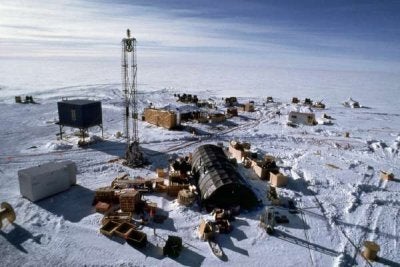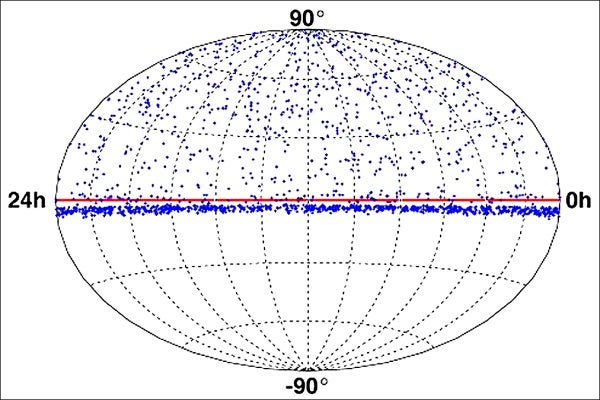For the first time in an effort spanning more than fifteen years, a multinational collaboration of astronomers has constructed a detailed map of the northern sky in the ghostly, high-energy glow of neutrinos. What’s more, they did it from the South Pole, with an upside-down telescope carved from Antarctic ice. The map covers the northern hemisphere and presents many possible neutrino sources.
One-and-a-half kilometers below Earth’s southern ice cap, 700 blue-light-sensitive, basketball-sized beads dangle on electric cables, forming a 500-meter by 120-meter cylindrical detector array named AMANDA (Antarctic Muon and Neutrino Detector Array). Specially designed for detecting high-energy neutrinos — a brand of subatomic particles born in the most violent cosmic events such as supernovae, black hole collisions and the Big Bang — AMANDA is the brainchild of University of Wisconsin-Madison physicist Francis Halzen.
“This is the first data with a neutrino telescope with realistic discovery potential,” says Halzen.
Scientists plan to augment AMANDA with 5,000 detectors in anticipation of one gargantuan ice array, to be dubbed IceCube, appropriately spanning a volume of one cubic kilometer below the ice sheet. AMANDA’s latest achievement signals a strong green light for IceCube.
The difficulty with mapping the sky in neutrinos is compounded by the elusive nature of these phantom particles. As neutrinos carry no charge and little, if any, mass, they pass right through just about anything — galaxy, star, planet, magnetic field, telescope mirror, or person. But this same uncooperative property of neutrinos also makes them prized, because a neutrino’s energy isn’t altered as it traverses the universe. If astronomers can catch a neutrino and determine where it came from, they can obtain a direct window to the very conditions that spawned it.
Each second, billions of neutrinos rip through Earth. And on relatively rare occasions, one of these interlopers will collide head-on with an Earth-bound proton or a neutron, creating a muon (heavy electron) with the same trajectory as the colliding neutrino. As supercharged muons traverse the pure subterranean Antarctic ice, they leave behind a trail of blue “Cherenkov” light. Determining where the neutrino came from becomes a matter of following the muon trail backwards.
Muons are also created by similar collisions with cosmic rays above Earth’s atmosphere. And that’s why telescopes like AMANDA go underground. Muons can’t travel through Earth like neutrinos can. Any muons coming up through the Antarctic ice sheet must have come from neutrinos raining down on the Northern Hemisphere.
Halzen and his colleagues caution that these advances, though extraordinary, are preliminary. They plan to augment and analyze the northern neutrino map throughout the coming year to pinpoint potential neutrino sources and to test AMANDA’s accuracy in preparation for the IceCube project.











